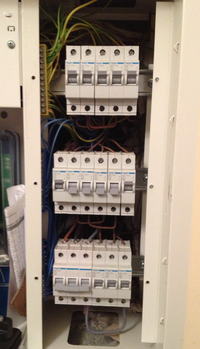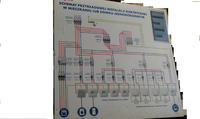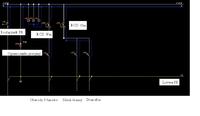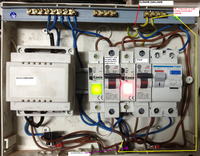Hello
I have had a problem with the differential in my house for several days, so I am asking you for advice.
I would like to point out that I am a layman in this matter, therefore I am asking for your understanding.
I will try to summarize.
Two weeks ago, one of the motors (230V) from the entrance gate, due to moisture, got a breakdown on the winding between N and PE, therefore the main differential worked, cutting off the power supply to the whole house.
I will just add that the gate from the very beginning, i.e. since it is installed, has " little "protection in the form of two miniature circuit breakers.
First of them ( Hager MB 116A ) is located in the main switch cabinet, and it protects a certain segment of the receivers in the basement. From this power supply there is a separate line for powering the entrance gate, a separate box is installed here, in which two overcurrent switches are installed ( GE B6 G61 - one secures the entrance gate, the other a video intercom )
And here, in front of the circuit breakers, I decided to add an additional differential.
The assumption was that at the time of the re-piercing, it would first knock out the difference in the basement, and the difference on the main board would remain "intact". I installed everything yesterday, the basement differential seems to be working fine because the button is pressed " test "causes it to disconnect, but another thing worries me. The so-called artificial creation of a puncture behind the differential between the N and PE conductors causes the breakout of both differentials, the one in the basement and the one on the main board, thus turning off the electricity in the whole house.
Below I present a "layman" diagram of how I have it connected.
I am asking for verification and some tips.
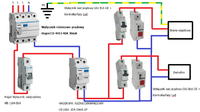
I have had a problem with the differential in my house for several days, so I am asking you for advice.
I would like to point out that I am a layman in this matter, therefore I am asking for your understanding.
I will try to summarize.
Two weeks ago, one of the motors (230V) from the entrance gate, due to moisture, got a breakdown on the winding between N and PE, therefore the main differential worked, cutting off the power supply to the whole house.
I will just add that the gate from the very beginning, i.e. since it is installed, has " little "protection in the form of two miniature circuit breakers.
First of them ( Hager MB 116A ) is located in the main switch cabinet, and it protects a certain segment of the receivers in the basement. From this power supply there is a separate line for powering the entrance gate, a separate box is installed here, in which two overcurrent switches are installed ( GE B6 G61 - one secures the entrance gate, the other a video intercom )
And here, in front of the circuit breakers, I decided to add an additional differential.
The assumption was that at the time of the re-piercing, it would first knock out the difference in the basement, and the difference on the main board would remain "intact". I installed everything yesterday, the basement differential seems to be working fine because the button is pressed " test "causes it to disconnect, but another thing worries me. The so-called artificial creation of a puncture behind the differential between the N and PE conductors causes the breakout of both differentials, the one in the basement and the one on the main board, thus turning off the electricity in the whole house.
Below I present a "layman" diagram of how I have it connected.
I am asking for verification and some tips.




